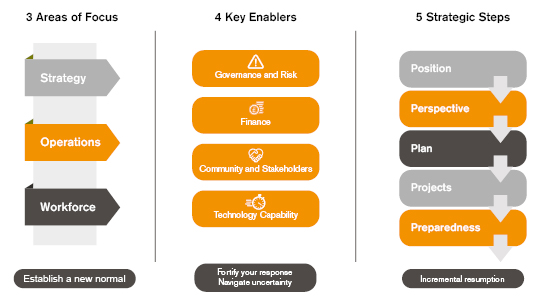Roadmap for business resilience:
Developing a strategic risk-based approach to doing business
Developing a recovery plan to help you navigate the ‘new normal’ is good governance and using a risk-based approach will mean you are better prepared for whatever the future may hold.
COVID-19 has exposed new risks. From social distancing to uncertain customer demand, a well-considered risk management approach will help you manage these new risks and support your planning and next steps.
Meanwhile significant risks that existed before the pandemic haven’t gone away. Now is a good time to reassess your strategic risks, as it’s likely these will have changed or increased.
Incremental resumption of business and services is key
It is necessary to fully appreciate the impact that COVID-19 has had on your culture, resources and capabilities; proceed with care and empathy as you resume your business or services. Weak data systems and inattentive risk management will set you back and potentially expose you. Take time to assess and understand the level of maturity of both within your organization.
We have created a Planning Framework together with a suite of tools below to help you to build your approach. You can use the tools to revisit and assess your organization's strategy and objectives and help assess the impact, risks and opportunities going forward.
Planning framework
Take a risk-based approach to your planning.
The following three connected and important components will help you to establish a short to medium-term strategic recovery plan that considers governance, resources and the processes required to successfully execute it.

Three (3) areas of focus

Revisit your strategic priorities and operations and consider workforce implications. For each area, ask yourself:
- What has happened?: What has the organization learned from the pandemic?
- What is the impact?: What impacts has the pandemic had on the organization - operations, workforce and community?
- What are the opportunities and risks?: What opportunities and risks have been identified?
Four (4) key enablers

The review of key enablers and influences is crucial to managing the objectives set in your recovery plan. Great plans are frequently let down because these four areas have not had sufficient oversight or assessment.
Our Key Enabler checklists below provide you with questions designed to help you start planning your recovery and the best use of resources.
Five (5) strategic steps
When building your recovery plan consider the following five strategic steps:

What is your position within the market and community?
- Who are your competitors?
- Have you lost ground?
- Is solvency a risk?
- Has your organization learned from the pandemic?
- What developments during the pandemic can you use as a lever?
- Has compliance been monitored and achieved?
- Is a new value proposition warranted?

Has the business and operating landscape changed for your organization?
- How prepared was the organization for a significant disruption and how well has it coped?
- What aspects of your culture and identity will change as a result of the pandemic?
- Is there a greater sense of unity and cooperation within the organization or less so?
- Will you see the organization differently when this is all over?
- Are you more resilient?

What will you do and what must you do?
- A lack of a plan exacerbates disorientation and uncertainty, giving rise to risk and limiting opportunities.
- Having reviewed the key areas of focus and assessed the key enablers, what actions can you take; what risks and opportunities will you pursue and how?

What elements of the plan are high priority and require careful coordination?
- What are the priorities for the organization’s resources?
- Be clear on the projects that will contribute to future-proofing the organization.
- Will the future bring the organization closer together or drive it apart?
- Too many initiatives can overwhelm an already stressful environment.
- Use project methodologies to manage elements that are higher risk and require close monitoring

Action plan (PDF)
- Do you know the risks associated with executing your recovery plan?
- How resilient are you for the next potential disruption?
By using the 5-P analysis and the Roadmap for business resilience tools you can identify your short to medium term priorities (Strategic Priorities) and what actions you need take (Action Plan) to start your planning (Strategic Plan and Risk Assessment) and trigger your recovery.
These tools intend to be a starting point that should be adapted to each organization’s specific context. They may not apply to everyone and are not intended as complete advice.